The gender gap in politics has widened in the last four years, according to recent polling.
Since women make up a slight majority of U.S. voters, any increase in turnout based on gender could tip the scales of this election, some analysts say.

The gender gap in politics has widened in the last four years, according to recent polling.
Since women make up a slight majority of U.S. voters, any increase in turnout based on gender could tip the scales of this election, some analysts say.